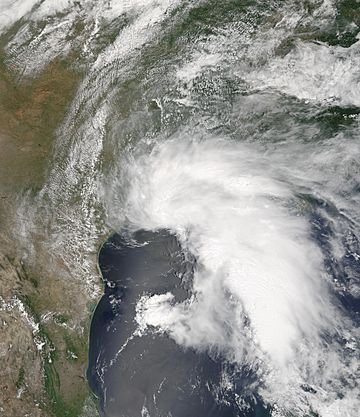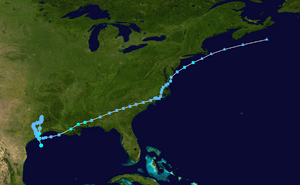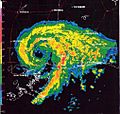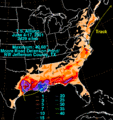Tropical Storm Allison facts for kids
| Tropical storm (SSHWS/NWS) | |

Tropical Storm Allison on June 5, 2001
|
|
| Formed | June 4, 2001 |
|---|---|
| Dissipated | June 18, 2001 |
| Highest winds | 1-minute sustained: 60 mph (95 km/h) |
| Lowest pressure | 1000 mbar (hPa); 29.53 inHg |
| Fatalities | 41 direct, 14 indirect |
| Damage | $5.5 billion (2001 USD) |
| Areas affected | Texas (mostly around Houston), Louisiana, most of the Eastern United States |
| Part of the 2001 Atlantic hurricane season | |
Tropical Storm Allison was a very powerful and damaging storm that hit the United States in 2001. It caused a lot of destruction, especially in Texas, around the city of Houston. Allison led to over $5 billion in damage. Sadly, 55 people lost their lives because of the storm.
Allison was unique because it was the first tropical storm in the Atlantic Ocean to have its name retired. This means its name will never be used again for another storm. Usually, only hurricanes have their names retired, but Allison was so destructive that it earned this rare distinction.
Contents
How Tropical Storm Allison Formed and Moved
The story of Tropical Storm Allison began far away. It started as a tropical wave that moved off the coast of Africa on May 21, 2001. This wave traveled a very long distance across the Atlantic Ocean and the Caribbean Sea.
It even crossed over South America and entered the Pacific Ocean. The wave then moved across southern Mexico and into the Gulf of Mexico. On June 4, this wave grew stronger and officially became Tropical Storm Allison. It skipped the stage of being a tropical depression.
On the same day it formed, Allison reached its strongest winds, blowing at 60 miles per hour (97 km/h). However, it soon weakened a bit to 50 miles per hour (80 km/h).
Allison's Landfalls and Journey
On June 5, Allison made its first landfall (when the center of a storm crosses land) near Freeport, Texas. Its winds were still at 50 miles per hour. After hitting land, Allison quickly weakened into a tropical depression.
The storm then moved very slowly across Texas. It reached a town called Lufkin before turning back towards the Gulf of Mexico. Allison finally reached the Gulf again on June 9. At this point, dry air caused it to change into a subtropical depression. A subtropical storm has features of both tropical and non-tropical storms.
On June 11, Allison made another landfall in Louisiana. It did this without becoming a tropical depression or tropical storm again. While over Louisiana, clouds gathered near its center, and Allison briefly became a subtropical storm. But it quickly weakened back to a subtropical depression.
Allison then moved northeast across the United States. By June 15, it was moving very slowly over North Carolina before curving north. Allison finally reached the Atlantic Ocean again on June 17. For a short time, while south of Long Island, New York, it became a subtropical storm one last time.
On June 17, Allison began to die out. It changed into an extratropical storm, which means it lost its tropical characteristics. The last parts of the storm completely disappeared near Newfoundland on June 20.
What Happened After the Storm
After Tropical Storm Allison passed, President George W. Bush declared many areas as disaster zones. This meant these places needed special help and funding to recover. A total of 75 counties and parishes (like counties) were named disaster areas.
Most of the damage from Allison happened in:
- Texas, especially the eastern parts
- Southern Louisiana
- Southern Mississippi
- Northwestern Florida
- Southeastern Pennsylvania
Why Allison's Name Was Retired
Because Tropical Storm Allison caused so much damage and loss of life, its name was officially "retired." This means the name "Allison" will never be used again for any future storm in the Atlantic Ocean. This is done to prevent confusion and to honor the victims of very destructive storms.
The name "Andrea" replaced "Allison" for the 2007 Atlantic hurricane season. Allison was the first tropical storm in Atlantic history to have its name retired. It remained the only one until Tropical Storm Erika in 2015.
|
Tropical cyclones of the 2001 Atlantic hurricane season Timeline |
|||||||||||||||||||||||||||||||||
|
|
||||||||||||||||||||||||||||||||
|
|
|||||||||||||||||||||||||||||||||
Images for kids
-
Subtropical Storm Allison with an eye-like feature over Mississippi
-
Subtropical Depression Allison over North Carolina on June 14
-
Buffalo Bayou and White Oak Bayou at Main Street after Tropical Storm Allison hit Houston
-
Flooding in Chackbay, Louisiana
-
Damage from flooding in Pennsylvania
-
Aid from the American Red Cross
See also
 In Spanish: Tormenta tropical Allison (2001) para niños
In Spanish: Tormenta tropical Allison (2001) para niños










